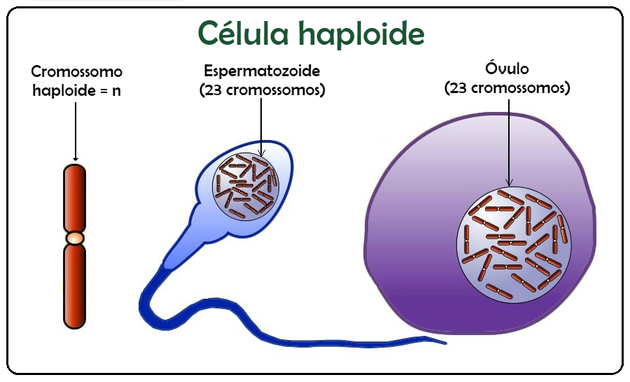Haploid and diploid cells represent the classification they receive according to the chromosomal set each has. Human beings have 46 chromosomes, that is, 23 pairs.
Reproductive cells are haploid and diploid cells are somatic, that is, related to tissue production.
What are haploid cells

Haploid cells are those that have only one set of chromosomes, represented by the letter n.
Reproduction of haploid cells occurs in meiosis. It is at this point in cell division that diploid cells divide and form haploid cells.
As an example of haploid organisms, we highlight the gametes, that is, sperm and eggs.
Gametes have 23 chromosomes so that, when they unite in fertilization, they are duplicated and thus present the 46 chromosomes. In this way, the gametes only exert their function when they find the gamete of the opposite sex to complete the genetic load.
See the table below for a summary of haploid cells.
| haploid cells | Description |
|---|---|
| Definition | A set of chromosomes (n). |
| reproduction | It happens from meiosis, which transforms the diploid cell into a haploid. |
| Example | Gametes (sperm and eggs). |
Also read about:
- Meiosis
- Gametes
- Genes and Chromosomes
What are diploid cells

Diploid cells are more complex, as they have two complete sets of chromosomes (2n).
This type of cell reproduces from mitosis, that is, when the diploid cells, which are the daughter cells, duplicate. These new cells form chromosomes in pairs and each set is called homologous, as they have identical shape, size and genes.
Diploid cells are present in living beings and in most animals, and can be found in somatic cells, such as those found in skin, blood and muscle cells.
Review the table below for a summary of diploid cells.
| diploid cells | Description |
|---|---|
| Definition | Two complete sets of chromosomes (2n). |
| reproduction | It happens from mitosis, which is the duplication of cells. |
| Example | Somatic cells, that is, cells that form tissues. |
Learn more about:
- Mitosis
- cell division
- human body tissue
Fun facts about haploid and diploid cells
- If all reproductive cells were diploid, during fertilization the chromosomes would be duplicated.
- There are still polyploid cells, with several sets of chromosomes. These cells are present in plants, as in humans they cause profound abnormality and even death.
Read too:
- Mitosis and meiosis: summary of processes, differences and exercises
- Introduction to genetics
- eukaryotic cells
- prokaryotic cells

